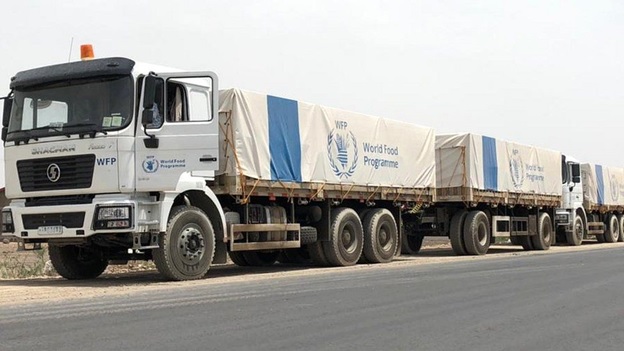By Peter Mwai
BBC Reality Check
The UN says hundreds of aid trucks which made the journey up to Tigray from other parts of Ethiopia between mid-July and mid-September have not returned.
We’ve been looking into what’s holding up the flow of desperately needed aid.
What’s happened to the aid trucks?
The main mode of delivering aid into Tigray has been via road, through the Afar region.

UN aid agencies estimate that 100 trucks with food, non-food items and fuel, need to enter Tigray every day.
In the two months to 16 September, 466 trucks had entered Tigray through the Afar region, but only 38 had made the return journey, according to the UN.
“At the moment, this is the primary impediment to moving humanitarian aid into Tigray.
“We are unable to assemble convoys of significant size due to lack of trucks,” a spokesperson for the World Food Programme said.
Why aren’t trucks returning from Tigray?
We’ve asked the UN where the trucks are, but they haven’t yet been able to provide clarification.
Tigrayan forces fighting the Ethiopian government and its allies have laid the blame at the door of the Ethiopian government.
“The truck drivers are provided with fuel that’s only [enough] for a one-way trip to Tigray. They are not provided [with] reserve fuel [to return] that is customary on such trips,” the Tigray People’s Liberation Front (TPLF) said in a statement.
It also says truck drivers – many of them ethnic Tigrayans – complain of violence and intimidation during inspections at checkpoints manned by the Ethiopian military and local security officials outside Tigray.
It says they are not willing to go through these again to make the return journey.
There are also restrictions on the amount of cash that can be carried, and with banking services suspended inside Tigray, there is no money available for them when they arrive.
The Ethiopian government accepts that the failure of trucks to return from Tigray is hindering the supply of food aid.
But Ethiopia’s Commissioner for National Disaster Risk Management, Mitiku Kassa, has rejected the suggestion that a shortage of fuel is stopping the trucks.
It’s also been suggested by government officials that trucks could have been seized by the TPLF.
So far there’s no evidence of this, although Tigrayan forces did enter neighbouring areas in Afar in late July, through which the main supply route passes.
What do we know about the fuel situation?
The UN Office for the Co-ordination of Humanitarian Affairs (OCHA), has made clear that the reasons cited by drivers not wanting to go back “are a lack of fuel to return, as well as drivers fearing for their security.”
The UN has for some weeks voiced concerns about the availability of fuel in Tigray, and has previously complained of fuel tankers being denied passage to the region.
“Clearance for the movement of fuel tankers to transit to Tigray was reportedly denied by authorities in Afar region,” the UN said early this month.
A meeting of the UN and other aid agencies in late August also mentioned a lack of cash and fuel as among challenges affecting the return of trucks, noting that they were only allowed to carry enough fuel to get to their destination.
The agencies said: “Due to this, the limitation of cash and the added difficulties in finding fuel,.. it is highly challenging for the trucks to return from [the Tigrayan capital] Mekelle.”
The UN estimates that 200,000 litres of fuel are needed each week, and says that since 12 July, only 300,000 litres have reached Tigray.
The last fuel tanker entered Tigray on 29 July and available fuel stocks were exhausted on 17 September, the UN says.
Nine tankers are stranded in Semera, the capital of the Afar region, as of 21 September, pending government approval to move into Tigray.
What about the security situation?
A humanitarian official in Tigray recently told AFP that many Tigrayan truck drivers had faced harassment at checkpoints outside their region.
The UN has said: “Among the reasons cited by the drivers are… fear for their security as they were subjected to beating, harassment, intimidation and theft on the route from Semera to Mekelle.”
The UN reported in August an incident of harassment and abuse of one of its own missions to Tigray to assess the road transport situation, which it blamed on armed police in Afar region.
The Ethiopian government says it’s reduced checkpoints along this route into Tigray from seven to two, in order to improve the movement of aid.
“Although this issue has been addressed to facilitate smooth flow, the number of trucks being dispatched by humanitarian actors has not [yet] increased,” said Billene Seyoum, the spokesperson for the Ethiopian Prime Minister’s office.
Source: BBC


